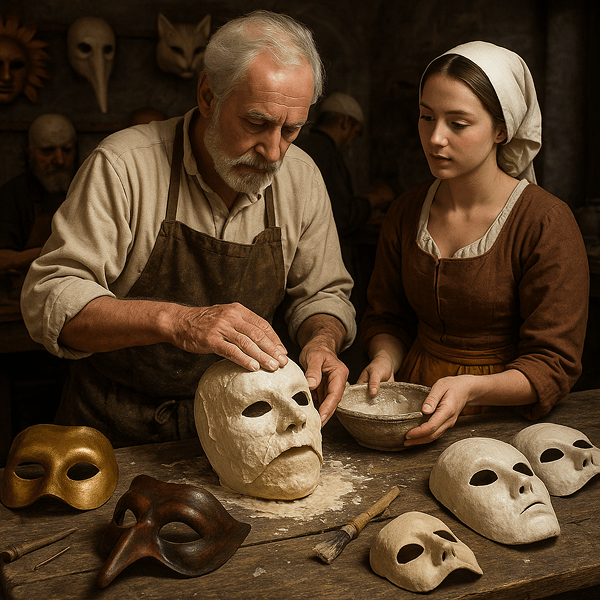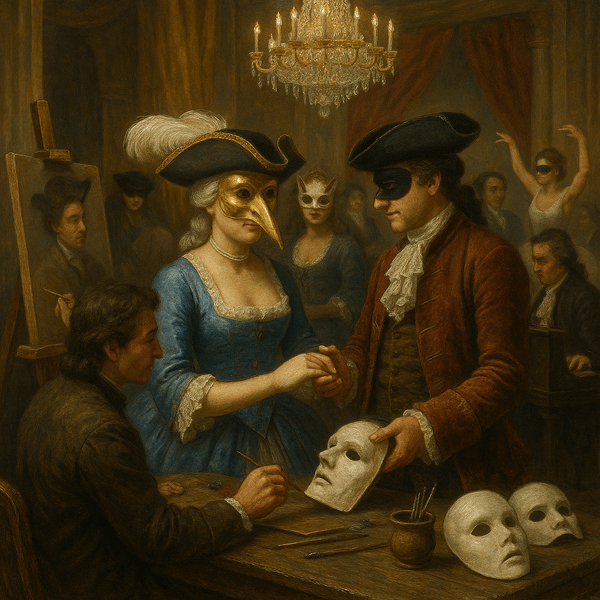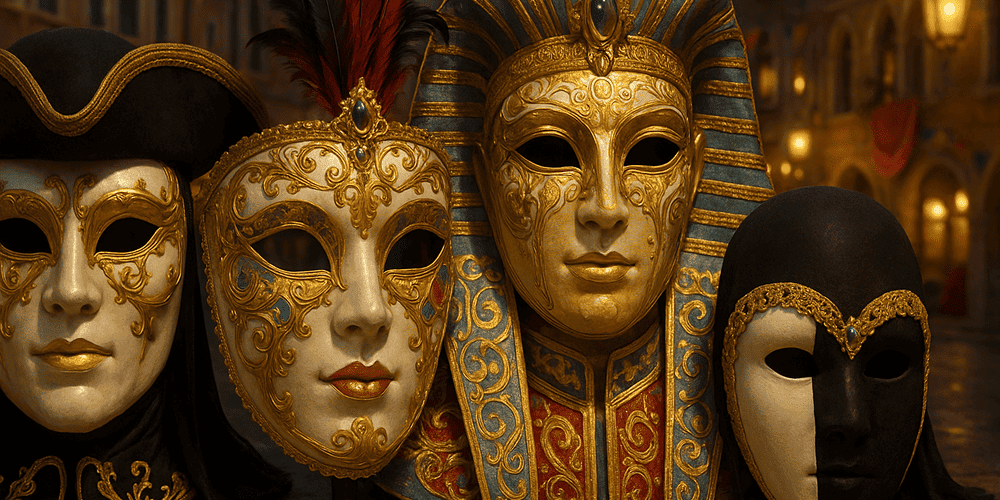Venetian Carnival Masks are among the most iconic and instantly recognizable symbols of Italy’s cultural heritage. Adorned with ornate decorations, gilded details, feathers, and vibrant colors, these masks are not just beautiful accessories — they are deeply embedded in the social, artistic, and historical fabric of Venice. Characterized by their elegant forms such as the Bauta, Colombina, Moretta, and Volto, Venetian Carnival Masks reflect centuries of craftsmanship and innovation. These masks originated in Venice during the Middle Ages and Renaissance, becoming central to the city’s legendary Carnival celebrations. Today, they continue to fascinate and inspire, standing as enduring emblems of Venetian culture and artistry.
Historical Origins of Venetian Carnival Masks
The origin of Venetian Carnival Masks can be traced back to the 12th century, with the first documented use during the Carnival of Venice (Carnevale di Venezia). The mask’s name is derived from the Italian word “maschera,” meaning mask or disguise. Historically, masks allowed Venetians to transcend social boundaries, permitting interactions and behaviors outside the rigid norms of daily life. During the Republic of Venice, masks were used not only during Carnival but also in various public festivals, private gatherings, and even during daily activities to protect anonymity and privacy.
Over the centuries, the design and function of Venetian Carnival Masks evolved. Early masks were simple in form, often made from leather or unadorned papier-mâché. By the Renaissance, masks became increasingly elaborate, incorporating gold leaf, jewels, lace, and intricate painting. Notable historical references include decrees by the Venetian Senate regulating mask use and artworks by painters like Pietro Longhi, who depicted masked figures in Venetian society. Surviving artifacts, such as antique masks preserved in Venetian museums, offer a tangible link to this storied past.
Cultural Significance and Symbolism of Venetian Carnival Masks
In Venetian society, Carnival masks have carried rich layers of meaning. They symbolize freedom, anonymity, and the temporary suspension of social order. Spiritually, masks were seen as a way to connect with otherworldly forces, allowing wearers to embody different personas or archetypes. Venetian folklore abounds with tales of masked intrigue, romance, and adventure, and certain masks, like the Bauta, were believed to offer protection against evil spirits.
Socially, Venetian Carnival Masks allowed people from different classes and backgrounds to mingle, celebrate, and even critique authority without fear of retribution. The mask thus became both a tool of liberation and a veil of mystery, central to the unique atmosphere of Venice’s Carnival. Many myths and legends — such as stories of masked lovers or political conspirators — are intertwined with the mask tradition, further cementing its place in Venetian cultural memory.
Materials and Crafting Techniques of Venetian Carnival Masks
Traditional Venetian Carnival Masks are crafted using time-honored techniques passed down through generations. The most common materials include papier-mâché, leather, and occasionally porcelain. Artisans, known as “maschereri,” begin by modeling the basic form over a sculpted mold. Layers of papier-mâché are then applied, pressed, and dried to create a lightweight yet durable structure.

Once shaped, the mask is hand-finished using gesso, followed by sanding and painting. Decorative techniques include the application of gold or silver leaf, glass beads, sequins, and lace. Brushes, palette knives, and specialized carving tools are used to achieve intricate designs. Regional differences exist within the Venetian Lagoon, with some workshops favoring minimalism and others indulging in maximalist ornamentation. Color symbolism is also significant — white for purity, gold for opulence, red for vitality, and black for mystery. Each mask is uniquely decorated, making it a one-of-a-kind work of art.
Functions and Uses of Venetian Carnival Masks
Venetian Carnival Masks have served multiple functions throughout history. Originally, they were worn during religious and civic rituals, processions, and public ceremonies to ensure anonymity and equality. In the theater, masks became essential props for commedia dell’arte performances, enabling actors to portray stock characters with exaggerated expressions.
During the Carnival of Venice, masks became synonymous with revelry, mischief, and the inversion of social norms. Over time, their use expanded from strictly ritual contexts to include balls, masquerade parties, and private gatherings. In the modern era, Venetian Carnival Masks are worn in parades, cultural festivals, and even as fashion accessories or collectible art pieces. While the tradition has evolved, the core function — to transform and enchant — remains unchanged. For those interested in Carnival Masks from other cultures, toddmasks.com provides a comparative overview and links to broader masking traditions.
Regional Variations of Venetian Carnival Masks
While the city of Venice is the heart of the Carnival mask tradition, subtle regional variations have emerged over time. Some Venetian islands, such as Murano and Burano, are known for integrating glasswork or lace into their mask designs. The Bauta and Moretta are uniquely Venetian, while the Columbina and Volto have found popularity in other Italian cities and across Europe.
Comparing Venetian Carnival Masks to similar traditions, such as the elaborate masks of Switzerland’s Fasnacht or the French Bal Masqué, reveals both shared roots and distinctive local adaptations. Venetian masks remain unparalleled in their artistry and variety, but they are part of a broader European tradition of masquerade and festive disguise.
Famous Examples and Collections of Venetian Carnival Masks
Some of the most famous Venetian Carnival Masks can be found in museum collections and private holdings around the world. The Museo di Palazzo Mocenigo and Ca’ Rezzonico in Venice house historic masks, costumes, and documents that illuminate the evolution of the tradition. The Museo delle Maschere in Rome and the Victoria and Albert Museum in London also feature remarkable examples.
Historic artifacts, such as 18th-century Bauta masks or original commedia dell’arte pieces, are highly prized by collectors. Noteworthy private collections often appear in international exhibitions and auctions, offering a glimpse into the craftsmanship and diversity of Venetian mask art. On toddmasks.com, enthusiasts can view curated galleries and learn more about the provenance of significant Venetian Carnival Masks.
Influence of Venetian Carnival Masks on Art and Culture
Venetian Carnival Masks have had a profound influence on visual arts, theater, literature, and music. Their dramatic forms have inspired painters from Canaletto to Picasso, while writers such as Casanova and Goldoni used masked characters to explore themes of identity, deception, and desire. In opera and ballet, the masked ball is a recurring motif, symbolizing both romance and intrigue.

In modern design, Venetian mask motifs appear in haute couture, jewelry, and set design. Fashion houses and contemporary artists frequently reinterpret mask aesthetics for new audiences, ensuring the tradition’s continued relevance. The preservation and celebration of Venetian Carnival Masks play a vital role in maintaining Venice’s cultural heritage and inspiring creative innovation worldwide.
Contemporary Status and Preservation of Venetian Carnival Mask Tradition
Today, the art of Venetian Carnival Mask-making is alive and thriving, thanks to dedicated artisans, family workshops, and cultural organizations. Modern masters combine traditional methods with contemporary materials, producing masks that honor the past while embracing new technologies. The city of Venice supports the tradition through festivals, competitions, and educational initiatives.
Efforts to preserve and transmit mask-making skills include apprenticeships, museum workshops, and school programs. Organizations such as toddmasks.com promote cultural education, host masterclasses, and provide resources for aspiring mask-makers. Recent innovations include eco-friendly materials, digital customization, and collaborations with international artists. These adaptations ensure that Venetian Carnival Masks remain a vital and evolving form of cultural expression.
Collecting and Purchasing Venetian Carnival Masks
The market for Venetian Carnival Masks is vibrant, ranging from affordable souvenirs to high-value collector’s items. Authentic masks can be purchased from established workshops in Venice, reputable galleries, and online platforms such as toddmasks.com. Prices vary widely, depending on the materials, craftsmanship, provenance, and decorative complexity.
When collecting, buyers should look for hallmarks of authenticity: artisan signatures, traditional techniques, and high-quality materials. Provenance and documentation add value, while mass-produced or plastic masks are generally less desirable. Ethical considerations are important — supporting local artisans and respecting cultural heritage ensures the sustainability of the tradition. Toddmasks.com offers guidance on identifying genuine Venetian Carnival Masks and navigating the market responsibly.
The Enduring Legacy of Venetian Carnival Masks
Venetian Carnival Masks are more than festive accessories — they are living symbols of creativity, tradition, and the enduring spirit of Venice. Their history spans centuries, weaving together art, ritual, and social change. As both cultural artifacts and contemporary fashion statements, these masks continue to captivate, inspire, and unite people across the globe. With ongoing support from artisans, collectors, and educational platforms like toddmasks.com, the Venetian Carnival Mask tradition is poised to flourish for generations to come.
